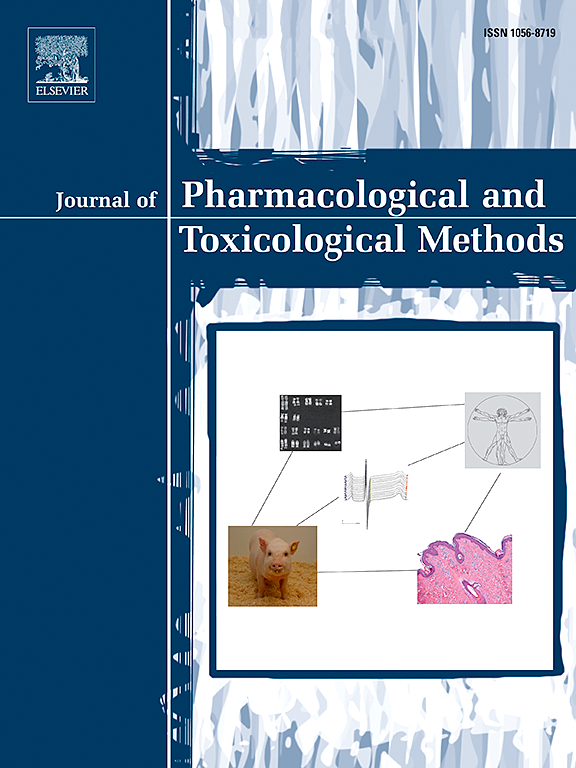A retrospective analysis of the concordance between cardiovascular effects in telemetry studies, toxicity studies, and early clinical trials
IF 1.8
4区 医学
Q4 PHARMACOLOGY & PHARMACY
Journal of pharmacological and toxicological methods
Pub Date : 2025-07-16
DOI:10.1016/j.vascn.2025.108385
引用次数: 0
Abstract
This work aimed to compare the ability of several ECG technologies used in toxicity studies to identify cardiovascular effects. A retrospective analysis of 41 drug development projects across the Roche portfolio from 2005 to 2023 was conducted to evaluate the concordance of snapshot ECG (SS-ECG) and jacket external telemetry (JET, with or without blood pressure assessment) to detect effects on heart rate, ECG, and blood pressure in toxicity studies, when compared to implanted telemetry as the gold standard. Overall, 132 non-clinical studies were investigated. For 24 projects, translation to phase 1 safety data under consideration of plasma exposures could be followed up. Company-internal strategic decisions on advancing certain molecules despite cardiovascular findings were subject to a risk-benefit assessment and not evaluated in this investigation.
SS-ECGs never detected changes in heart rate (HR) previously revealed in telemetry studies, whereas JET identified these in all telemetry-positive cases. JET (or M11 implants) detected 44 % and SS-ECGs identified 33 % of QTc increases in telemetry-positive molecules, indicating that stand-alone telemetry is still the most reliable in vivo study in identifying QTc-effects. No clear species differences between beagle dogs, Göttingen minipigs or cynomolgus monkeys were evident when comparing heart rate and QTc detection. HR increases were noted clinically in about 50 % of the non-clinical positive cases, whereas HR decreases were never detected in clinical trials. Non-clinical blood pressure decreases showed higher translatability to humans (at least 80 %) than blood pressure increases (29 %), with a high prevalence of dogs and minipigs showing a signal. Non-clinical QTc increases detected by JET and/or telemetry were confirmed in 3 clinical studies analyzed with concentration/QTc modeling, however in 7 clinical studies employing other methodologies to measure QT, the non-clinical QTc effects did not translate.
遥测研究、毒性研究和早期临床试验中心血管效应一致性的回顾性分析。
这项工作旨在比较几种ECG技术在毒性研究中用于识别心血管影响的能力。回顾性分析了2005年至2023年罗氏投资组合中的41个药物开发项目,以评估快照ECG (SS-ECG)和导管外遥测(JET,有或没有血压评估)的一致性,以检测毒性研究中对心率、ECG和血压的影响,并与植入式遥测作为金标准进行比较。总共调查了132项非临床研究。对于24个项目,考虑到血浆暴露,可将其转化为1期安全性数据。尽管有心血管方面的发现,但公司内部关于推进某些分子的战略决策需要进行风险-收益评估,而在本研究中未进行评估。SS-ECGs从未检测到遥测研究中发现的心率(HR)变化,而JET在所有遥测阳性病例中都发现了这些变化。JET(或M11植入物)检测到44. %的遥测阳性分子QTc增加,SS-ECGs检测到33. %的遥测阳性分子QTc增加,表明独立遥测仍然是鉴定QTc影响的最可靠的体内研究。在比较心率和QTc检测时,比格犬、Göttingen迷你猪和食蟹猴之间没有明显的物种差异。在约50% %的非临床阳性病例中,临床发现HR升高,而在临床试验中从未发现HR降低。非临床血压下降对人类的可翻译性(至少80% %)高于血压升高(29% %),狗和迷你猪的高流行率显示出信号。在3项采用浓度/QTc模型分析的临床研究中,JET和/或遥测检测到的非临床QTc增加得到证实,然而在7项采用其他方法测量QT的临床研究中,非临床QTc效应没有转化。
本文章由计算机程序翻译,如有差异,请以英文原文为准。
求助全文
约1分钟内获得全文
求助全文
来源期刊

Journal of pharmacological and toxicological methods
PHARMACOLOGY & PHARMACY-TOXICOLOGY
CiteScore
3.60
自引率
10.50%
发文量
56
审稿时长
26 days
期刊介绍:
Journal of Pharmacological and Toxicological Methods publishes original articles on current methods of investigation used in pharmacology and toxicology. Pharmacology and toxicology are defined in the broadest sense, referring to actions of drugs and chemicals on all living systems. With its international editorial board and noted contributors, Journal of Pharmacological and Toxicological Methods is the leading journal devoted exclusively to experimental procedures used by pharmacologists and toxicologists.
 求助内容:
求助内容: 应助结果提醒方式:
应助结果提醒方式:


